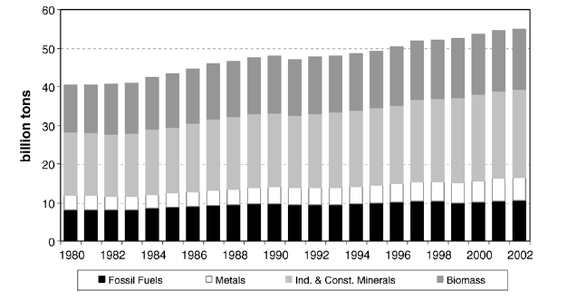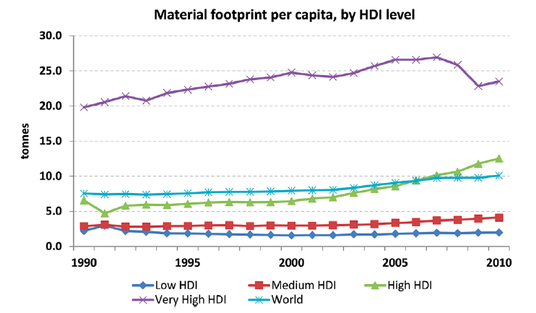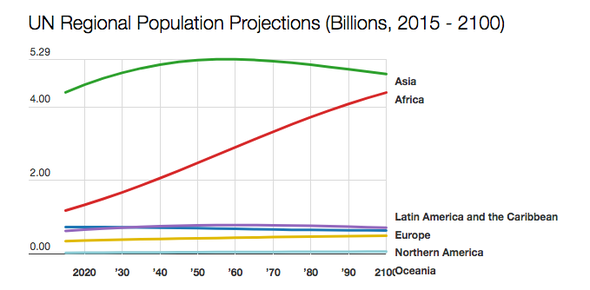System Earth - The Game
System Earth - the game
- Energy
- Water
- Climate Change
- Food
- Natural resources
- E-waste
Myself I did topics 5 and 6 because those are the ones that I am mostly interested on. While doing the supplementary information for both of them, a recurring thought came to my mind related to the emancipation of developing nations.
Here's a transcript of the natural resource section. Bear in mind that wording has been adapted to fit the audience!
Resource consumption
But why does a population increase translate into more resources consumed? Well the answer is very straightforward and you just need to look around you. To construct a building, we require huge amounts of materials like cement, bricks, steel, etc. A car is basically composed of metals of different qualities called alloys. Once materials are extracted and transformed into buildings and cars, they remain in stock for a long period. The world's most extracted materials are 1) industrial & construction materials, 2) biomass, 3) fossil fuels and 4) metals [5]. The historic graph shown above highlights the share of resources needed to build-up our society in terms of industrial & construction materials and metals. Fossil fuels are a big part also as they are used to as fuel for cars, heating for homes, to produce plastics and etc.
Rich
countries in the world consume on average 10 times more materials than
poor countries [3]. This translates into a world average footprint of
material consumption of around 10 tonnes/year. But let's not forget that
for the average to be 10 and given that most of the world is not as
developed as rich countries, billions of people in the planet consume
1-3 tonnes/year. The imbalance is worrisome!But why does a population increase translate into more resources consumed? Well the answer is very straightforward and you just need to look around you. To construct a building, we require huge amounts of materials like cement, bricks, steel, etc. A car is basically composed of metals of different qualities called alloys. Once materials are extracted and transformed into buildings and cars, they remain in stock for a long period. The world's most extracted materials are 1) industrial & construction materials, 2) biomass, 3) fossil fuels and 4) metals [5]. The historic graph shown above highlights the share of resources needed to build-up our society in terms of industrial & construction materials and metals. Fossil fuels are a big part also as they are used to as fuel for cars, heating for homes, to produce plastics and etc.
 |
| Figure 1: Evolution of natural resource extraction in terms of its categories. From [5] |
Materials stocked in society
Rich developed countries have been enjoying great prosperity from the beginning the industrial revolution in the end of the 19th century until today. This prosperity will continue as our society continues to exist. We have now achieved unprecedented levels of development and comfort. 60% of all the materials that the world has ever extracted are stocked in rich countries [4] in the form of bridges, roads, buildings, cars, etc. The rest is distributed between 20% in China and 20% in the rest of the world. But that's not the real picture because as rich countries have achieved nice levels of development, the rest of the world and China are catching up, and they're doing that fast!
The Human Development Index (HDI)
This index developed by the United Nations (UN) gives an overview of what is the level of life of people across the world.
 |
| Figure 2: Material footprint by HDI. From: [3] |
This index developed by the United Nations (UN) gives an overview of what is the level of life of people across the world.
Often when people want to
compare living conditions between countries or to classify countries as
developed or in development, the HDI is used. It is estimated that 85%
of the world population is not considered as living in a developed
country. As a comparison, the US (high HDI) has a material footprint of
around ±25 tonnes/person whereas African countries (low HDI) have ±2.5
tonnes/person.
Now let's make a simple exercise:
- As part of the United Nations Sustainable Development Goals (SDGs), living conditions across countries in the world must improve.
- Continents like Africa and Asia will have the largest share of the population worldwide.
- The African economic situation is expected to be much higher in the coming decades compared to what it is today. Massive urbanization rate increases in the African/Asian continents will increase demand for infrastructure.
- Better living conditions means as we know more materials to build infrastructure, houses, etc to achieve higher HDI levels.
- Natural resource extraction already tripled from 1970 till 2010. How many more times must it increase in order for every human on earth have decent life conditions?!
 Figure 3: Population evolution. From: worldbank.org
Figure 3: Population evolution. From: worldbank.org
As seen in the graph on
the right, Africa and Asia will have the largest populations in the
world by the end of the century. They are expected to have 80% of the
world population. At the same time most of these countries present very
low levels of HDI when compared to developed countries. It's easy to
understand that at this rate we'll be extracting by 2050 around 180
billion kg of natural resources per year from the 70 billion kg in 2010
[3]. This is a 3 fold increase! Bad news is that this means that we will
never reach the goals of the Paris Climate Agreement [4]. To extract,
transform and produce all the required materials for this societal
transformation in Africa and in other countries, CO2 emissions will also
be rising equally :(
ConclusionNatural resource extraction has grown more than 3 times 1970. It will again grow 3 times until 2050. Maybe from 2050 till 2100 we will once again double resource extraction. In the meanwhile CO2 emissions associated with natural resource extraction will not cease to drop as more and more countries reach a fair level of human development index.
ConclusionNatural resource extraction has grown more than 3 times 1970. It will again grow 3 times until 2050. Maybe from 2050 till 2100 we will once again double resource extraction. In the meanwhile CO2 emissions associated with natural resource extraction will not cease to drop as more and more countries reach a fair level of human development index.
References:
- https://ourworldindata.org/world-population-growth#long-run-historical-perspective
- https://friendsoftheearth.uk/sites/default/files/downloads/overconsumption.pdf
- Schandl, Heinz, et al. "Global material flows and resource productivity: forty years of evidence." Journal of Industrial Ecology (2017).
- Krausmann, Fridolin, et al. "Global socioeconomic material stocks rise 23-fold over the 20th century and require half of annual resource use." Proceedings of the National Academy of Sciences 114.8 (2017): 1880-1885.
- Behrens, Arno, et al. "The material basis of the global economy: Worldwide patterns of natural resource extraction and their implications for sustainable resource use policies." Ecological Economics 64.2 (2007): 444-453.



Comments
Post a Comment